
The Pilgrims, also known as the Pilgrim Fathers, were the English settlers who traveled to America on the Mayflower and established the Plymouth Colony in Plymouth, Massachusetts. The Pilgrims' leadership came from the religious congregations of Brownists, or Separatist Puritans, who had fled religious persecution in England for the tolerance of 17th-century Holland in the Netherlands.

Plymouth Colony was the first permanent English colony in New England from 1620 to 1691 and the second permanent English colony in America, after the Jamestown Colony. It was settled by the passengers on the Mayflower at a location that had previously been surveyed and named by Captain John Smith. The settlement served as the capital of the colony and developed as the town of Plymouth, Massachusetts. At its height, Plymouth Colony occupied most of the southeastern portion of Massachusetts. Many of the people and events surrounding Plymouth Colony have become part of American folklore, including the American tradition of Thanksgiving and the monument of Plymouth Rock.

Plymouth is a town in Plymouth County, Massachusetts, United States. Located in Greater Boston, the town holds a place of great prominence in American history, folklore, and culture, and is known as "America's Hometown". Plymouth was the site of the colony founded in 1620 by the Mayflower Pilgrims, where New England was first established. It is the oldest municipality in New England and one of the oldest in the United States. The town has served as the location of several prominent events, one of the more notable being the First Thanksgiving feast. Plymouth served as the capital of Plymouth Colony from its founding in 1620 until the colony's merger with the Massachusetts Bay Colony in 1691. The English explorer John Smith named the area Plymouth and the region 'New England' during his voyage of 1614. It was a later coincidence that, after an aborted attempt to make the 1620 trans-Atlantic crossing from Southampton, the Mayflower finally set sail for America from Plymouth, England.
Historical archaeology is a form of archaeology dealing with places, things, and issues from the past or present when written records and oral traditions can inform and contextualize cultural material. These records can both complement and conflict with the archaeological evidence found at a particular site. Studies focus on literate, historical- period societies as opposed to non-literate, prehistoric societies. While they may not have generated the records, the lives of people for whom there was little need for written records, such as the working class, slaves, indentured labourers, and children but who live in the historical period can also be the subject of study. The sites are found on land and underwater. Industrial archaeology, unless practiced at industrial sites from the prehistoric era, is a form of historical archaeology concentrating on the remains and products of industry and the Industrial era.
James Deetz was an American anthropologist, often known as one of the fathers of historical archaeology. His work focused on culture change and the cultural aspects inherent in the historic and archaeological record, and was concerned primarily with the Massachusetts and Virginia colonies. James Deetz was interested in obtaining valuable information that could be used to better understand the lives of early North American colonists, natives, and African Americans. He investigated a variety of material culture related to these groups to better comprehend their social behavior.

A shotgun house is a narrow rectangular domestic residence, usually no more than about 12 feet (3.5 m) wide, with rooms arranged one behind the other and doors at each end of the house. It was the most popular style of house in the Southern United States from the end of the American Civil War (1861–65) through the 1920s. Alternative names include shotgun shack, shotgun hut, shotgun cottage, and in the case of a multihome dwelling, shotgun apartment; the design is similar to that of railroad apartments.

Elizabeth Poole or Pole was an English settler in Plymouth Colony who founded the town of Taunton, Massachusetts. She was the first woman known to have founded a town in the Americas.

This is a list of the National Register of Historic Places listings in Plymouth County, Massachusetts.

Flowerdew Hundred Plantation dates to 1618/19 with the patent by Sir George Yeardley, the Governor and Captain General of Virginia, of 1,000 acres (400 ha) on the south side of the James River. Yeardley probably named the plantation after his wife's wealthy father, Anthony Flowerdew, just as he named another plantation "Stanley Hundred" after his wife's wealthy mother, Martha Stanley. A "hundred" was historically a division of a shire or county. With a population of about 30, the plantation was economically successful with thousands of pounds of tobacco produced along with corn, fish and livestock. Sir George paid 120 pounds to build the first windmill in British America.
Christopher C. Fennell is an American anthropologist and lawyer, an Assistant Professor of Anthropology at the University of Illinois, Urbana-Champaign. His first book Crossroads and Cosmologies: Diasporas and Ethnogenesis in the New World (2008) received the John L. Cotter Award from the Society for Historical Archaeology. Fennell is editor of the African Diaspora Archaeology Network and Newsletter, and an associate of the editorial board of the International Journal of Historical Archaeology.

The Town Brook Historic and Archeological District is a historic district encompassing much of the length of Town Brook and its surrounding landscape in Plymouth, Massachusetts. This area has an industrial history that extends to 1620, when the Pilgrims arrived on the Mayflower and established Plymouth Colony. It extends roughly from the crossing of Billington Street, to the mouth of the brook in Plymouth Harbor. The district was listed on the National Register of Historic Places in 1995.

The John and Priscilla Alden Family Sites is a National Historic Landmark consisting of two separate properties in Duxbury, Massachusetts. Both properties are significant for their association with John Alden, one of the settlers of the Plymouth Colony who came to America on board the Mayflower and held numerous posts of importance in the colony. Alden and his relationship with Priscilla Mullins were memorialized by Henry Wadsworth Longfellow in The Courtship of Miles Standish, a fictionalized narrative poem that made the story a piece of American folklore.

The Old Town Historic District is a historic district in North Attleborough, Massachusetts, which encompasses the historic early town center of Attleboro, which it was originally a part of. It was here that Attleboro's first church was built, and its militia training ground was laid out. The district retains 18th-century vestiges of this early history, and was largely bypassed by 19th-century industrialization. The district was added to the National Register of Historic Places in 1991.

The New England Colonies of British America included Connecticut Colony, the Colony of Rhode Island and Providence Plantations, Massachusetts Bay Colony, Plymouth Colony, and the Province of New Hampshire, as well as a few smaller short-lived colonies. The New England colonies were part of the Thirteen Colonies and eventually became five of the six states in New England, with Plymouth Colony absorbed into Massachusetts and Maine separating from it. Captain John Smith's 1616 work A Description of New England first applied the term "New England" to the coastal lands from Long Island Sound to Newfoundland.
Cato Howe was an enslaved African American Black Patriot spy and courier during the American Revolution. Cato's enslaver, Hercules Mulligan, gathered intelligence through his personal connections as well as clients at his New York City tailoring shop, and Cato carried the information on horseback to Continental Army officers and other revolutionaries, including Alexander Hamilton and George Washington, and often through British-held territory. Cato's messages are credited with likely saving Washington's life on two occasions. Other than his intelligence activities with Mulligan, little definite information about Cato is available, though an excavation of his home after the war provides historians with more information about his life after the war.

The Aptucxet Trading Post Museum is a small open-air historical museum in Bourne, Massachusetts. The main attraction is a replica of the 17th-century Aptucxet Trading Post which was built by the Pilgrims of Plymouth Colony in order to trade with the Wampanoag Indians and the Dutch. The museum also features a replica of a 19th-century saltworks, the relocated 19th-century Gray Gables Railroad Station, and a wooden smock windmill. The property was listed on the National Register of Historic Places in 2021.

Capt. Jonathan Alden Sr., the son of Mayflower immigrants, was a military officer and farm owner in Plymouth Colony. The home he built in the late 1600s is now a National Historic Landmark in Duxbury, Massachusetts.
In Small Things Forgotten: An Archaeology of Early American Life was originally published in 1977 by anthropologist James Deetz. The book presents the idea that small objects can play big parts in an individual's life, and should therefore not be taken lightly in an archaeological investigation. The book is one of Deetz's most popular, and has become a staple piece of literature for those studying historical archaeology.
Whittlesey culture is an archaeological designation for a Native American people, who lived in northeastern Ohio during the Late Precontact and Early Contact period between A.D. 1000 to 1640. By 1500, they flourished as an agrarian society that grew maize, beans, and squash. After European contact, their population decreased due to disease, malnutrition, and warfare. There was a period of long, cold winters that would have impacted their success cultivating food from about 1500.

Pejepscot, Maine is a historical settlement first occupied by a subset of the Androscoggin Native Americans known as the Wabanaki. The region encompasses the current towns of Brunswick, Topsham and Harpswell, Maine in Sagadahoc and Cumberland counties and was first settled by English settlers in 1628.

















